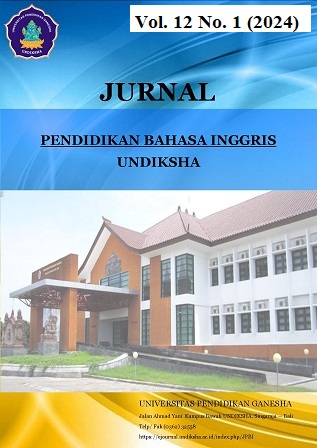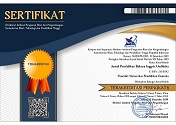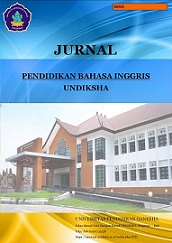E-Storybooks as Supplementary Material for Fourth Grade Elementary School Students
DOI:
https://doi.org/10.23887/jpbi.v12i1.81108Keywords:
e-storybook, supplementary material, young learners, Merdeka curriculumAbstract
The source of English learning materials used at school was only textbook without any supplementary materials. Supplementary materials in English teaching and learning process are considered as one of the ways to engage students in learning. This study aims to develop e-storybooks for fourth-grade pupils as supplementary materials based on the Merdeka curriculum. This Design and Development study used the ADDE model as proposed by Richey and Klein (2014). Qualitative and quantitative approach were used to analyze both non numerical and numerical data sequentially. English teacher and grade four students were involved as the subject of this study. Experts and user who validated the e-storybooks gave an overall score of 5 that showed the developed e-storybooks was the “Excellent Product” and valid to be used. Therefore, the developed e-storybooks can be used by grade four students to learn English in fun and interactive way. As these e-storybooks have various components that match to the students’ needs and the current curriculum, teacher was suggested to utilize it as the supplementary materials in English teaching and learning process.
References
Anderson, T., & Dron, J. (2011). International review of research in open and distributed learning. International Review of Research in Open and Distributed Learning, 12(3), 80–97. https://www.erudit.org/en/journals/irrodl/2011-v12-n3-irrodl05132/1067616ar/abstract/.
Asrimawati, I. F., & Margana, M. (2020). Using reading while listening to develop students ’ receptive skills : a. September, 213–218. https://doi.org/10.21070/jees.v5i2.840.
Bajrami, M. (2020). The use of supplementary materials for teaching high school students in EFL. Anglisticum Journal (IJLLIS), November, 10–16. https://doi.org/10.5281/zenodo.4441239.
Cahyati, S. S., Parmawati, A., Atmawidjaja, N. S., & Siliwangi, I. (2019). Optimizing English Teaching and Learning Process To Young Learners (a Case Study in Cimahi). Journal of Educational Experts P-ISSN, 2(2), 2614–3518. https://doi.org/10.30740/jee.v2i2p107-114.
Cherrez, N. M. G., Montalvan, J. P. M., Brito, E. O. G., & Ochoa, S. K. M. (2018). The Use of Supplementary Materials for Teaching Children in EFL Classes. https://doi.org/10.26820/recimundo/2.(4).octubre.2018.139-159.
Dhirapriyani, K., Suprianti, G. A. P., & Budiarta, L. G. R. (2024). Empowering first- grade students ’ learning : enhancing education through English e-Storybooks aligned with the emancipated curriculum. The Art of Teacihing English as a Foreign Language, 5(1), 32–48. https://doi.org/10.36663/tatefl.v5i1.665.
Erfani, H. (2019). Research and Development. In LAP Lambert. LAP Lambret Academy Publishing. https://doi.org/10.12968/npre.2007.5.5.23745.
Giguashvili, T., & Sanaia, D. (2023). Supplementary materials and multilingual classroom. International Journal of Multilingual Education, 9601, 60–70. https://doi.org/10.22333/ijme.2023.22000.
Hadiyanti, K. M. W., & Yolanda, M. (2021). Insights into prospective teachers’ beliefs in TEYL. LLT Journal: A Journal on Language and Language Teaching, 24(1), 36–50. https://doi.org/10.24071/llt.v24i1.2484.
Hendratno, H., Yermiandhoko, Y., & Yasin, F. N. (2022). Development of interactive story book for ecoliteration learning to stimulate reading interest in early grade students elementary school. IJORER : International Journal of Recent Educational Research, 3(1), 11–31. https://doi.org/10.46245/ijorer.v3i1.179.
Hsieh, M., Wang, F., & Lee, S. (2011). A corpus-based analysis comparing vocabulary input from storybooks and textbooks. The International Journal of Foreign Language Teaching, 6(1), 25–33. https://search.proquest.com/openview/4d5294f4b821eeccb1dd3098c770040e/1?pq-origsite=gscholar&cbl=18750&diss=y.
Hüseyin, K., & Balcı, A. (2016). Impact of storybook type on kindergarteners ’ storybook comprehension. Early Child Development & Care, November. https://doi.org/10.1080/03004430.2016.1188297.
Lieung, K. W., Rahayu, D. P., & Yampap, U. (2021). Interactive e-book to improve student ’ s problem solving. Jurnal Ilmiah Sekolah Dasar, 5(1), 8–15. https://ejournal.undiksha.ac.id/index.php/JISD/article/view/29814.
Lubaale, Y. A. M., Nakabugo, G., & Nassereka, F. (2021). Learning outcome in literacy and numeracy in Uganda: Mining Uwezo assessment data to demonstrate the importance of maternal education. IASSIST Quarterly, 45(3–4), 1–15. https://doi.org/10.29173/iq1001.
Nurliana, N. (2019). Developing a model of supplementary English materials based on local content. Journal of English Language Studies, 4(1), 86. https://doi.org/10.30870/jels.v4i1.4834.
Pujiani, T., Zuhrufillah, I., Sukmawati, I. D., & Listiani. (2023). The effectiveness of e-storybook in improving young learners’ vocabulary mastery. TEFLIN International Conference in Conjuction with 3rd ENglish Education International Conference, 330–338. https://jurnal.usk.ac.id/EEIC/article/view/37157.
Pujiani, T., Zuhrufillah, I., Sukmawati, I. D., & Yani, R. F. (2022). Engaging Young Learners to Study English Through Storytelling Using E-Storybook. The Proceedings of the English Language Teaching, Literature, and Translation (ELTLT), 11(1), 77–85. https://proceeding.unnes.ac.id/index.php/eltlt/article/view/1661.
Rahman, F., & Saputra, N. (2021). English as International Language Revisited: Implications on South Korea’s ELT Context. Scope : Journal of English Language Teaching, 6(1), 08. https://doi.org/10.30998/scope.v6i1.9383.
Raja, P., Flora, Putrawan, G. E., & Razali, A. B. (2022). English as an international language: perceptions of EFL preservice teachers in higher education institutions in Indonesia. Education Research International, 2022. https://doi.org/10.1155/2022/3234983.
Ratminingsih, N. M., & Budasi, I. G. (2018). Local culture-based picture storybooks for teaching English for young learners. SHS Web of Conferences, 00016, 1–6. https://doi.org/10.1051/shsconf/20184200016.
Ratminingsih, N. M., Budasi, I. G., & Kurnia, W. D. A. (2020). Local culture-based storybook and its effect on reading competence. International Journal of Instruction, 13(2), 253–268. https://doi.org/10.29333/iji.2020.13218a.
Rizal, A., Sahmadan, S., & Ajam, A. (2024). The effects of electronic storybook on EFL students ’ reading performance. Prosiding Seminar Nasional Pendidikan FKIP Universitas Lampung, 57–65. http://e-jurnal.fkip.unila.ac.id/index.php/prosem/article/view/447.
Smith, E. E., Kahlke, R., & Judd, T. (2020). Not just digital natives: Integrating technologies in professional education contexts. Australasian Journal of Educational Technology, 36(3), 1–14. https://doi.org/10.14742/ajet.5689.
Suhardiana, I. P. A., & Lestari, N. L. G. W. (2020). Enhancing students’ literacy skills through the use of English storybooks. Yavana Bhasha : Journal of English Language Education, 1(1), 80. https://doi.org/10.25078/yb.v1i1.1380.
Suprianti, G. A. ., Mahayanti, N. W. ., & Suarjaya, P. A. A. . (2020). Learning English in third grade through Powtoon. Journal of Education Technology, 4, 120–126. https://doi.org/10.23887/jet.v4i2.24087.
Suprianti, G. A. P. (2020). Powtoon animation video: a learning media for the sixth graders. VELES Voices of English Language Education Society, 4(2), 152–162. https://doi.org/10.29408/veles.v4i2.2536.
Suprianti, G. A. P., Budiarta, L. G. R., & Indrayani, L. (2024). Powtoon: Does it promote primary students’ autonomous learning? Journal of English Education and Teaching, 8(2), 355–372. https://doi.org/10.33369/jeet.8.2.355-372.
Suprianti, G. A. P., & Jayanta, I. N. L. (2020). Coping with Young Learners’ Vocabulary in EFL Classes. The Asian EFL Journal October, 27(4.5), 90–101. https://doi.org/10.23887/jet.v5i2.32758.
Tangkakarn, B. (2020). The effects of reading-while-listening and listening-before-reading- while-listening on listening and vocabulary. International Journal of Instruction, 13(3), 789–804. https://doi.org/10.29333/iji.2020.13353a.
Wahyuni, L. G. E., & Pratiwi, N. P. A. (2021). Enhancing EFL students ’ speaking competency through animated learning video. 4th International Conference on Innovative Research Across Disciplines, 613(Icirad), 181–187. https://doi.org/10.2991/assehr.k.211222.029.
Wahyuni, L. G. E., & Tantri, A. A. S. (2020). English learning media for EFL elementary learners. 3rd International Conference on Innovative Research Across Disciplines, 394(Icirad 2019), 209–216. https://doi.org/10.2991/assehr.k.200115.034.
Winaldo, M. D., & Oktaviani, L. (2022). Influence of video games on the acquisition of the English language. Journal of English Language Teaching and Learning, 3(2), 21–26. https://doi.org/10.33365/jeltl.v3i2.1953.
Wulandari, N. L. P. T., Ratminingsih, N. M., & Ramendra, D. P. (2020). Strategies Implemented in Teaching English for Young Learners in Primary School. Journal of Education Research and Evaluation, 2(3), 227–233. https://doi.org/10.23887/jere.v4i3.26228.
Yulfi, Y., & Syaprizal, S. (2020). Developing supplementry speaking material in digital media. Linguistic, English Education and Art (LEEA) Journal, 4(1), 150–160. https://doi.org/10.31539/leea.v4i1.1620.
Downloads
Published
Issue
Section
License
Copyright (c) 2024 Luh Dewi Asih, GAP Suprianti, Luh Gede Eka Wahyuni

This work is licensed under a Creative Commons Attribution-ShareAlike 4.0 International License.
Authors who publish with the Jurnal Pendidikan Bahasa Inggris Undiksha agree to the following terms:- Authors retain copyright and grant the journal the right of first publication with the work simultaneously licensed under a Creative Commons Attribution License (CC BY-SA 4.0) that allows others to share the work with an acknowledgment of the work's authorship and initial publication in this journal
- Authors are able to enter into separate, additional contractual arrangements for the non-exclusive distribution of the journal's published version of the work (e.g., post it to an institutional repository or publish it in a book), with an acknowledgment of its initial publication in this journal.
- Authors are permitted and encouraged to post their work online (e.g., in institutional repositories or on their website) prior to and during the submission process, as it can lead to productive exchanges, as well as earlier and greater citation of published work. (See The Effect of Open Access)













